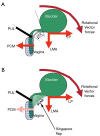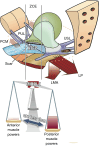Tethered vagina syndrome: massive urine loss caused by bladder neck scarring cured by skin graft
- PMID: 38721454
- PMCID: PMC11075954
- DOI: 10.21037/atm-23-1866
Tethered vagina syndrome: massive urine loss caused by bladder neck scarring cured by skin graft
Abstract
The bladder neck area of the vagina is known as the "zone of critical elasticity" (ZCE). Adequate vaginal elasticity at ZCE is required for the oppositely-acting muscles to independently close the distal urethra and bladder neck. Scarring at ZCE "tethers" the more powerful posterior muscles to the anterior muscles and the bladder neck is forcibly pulled open, resulting in massive urine loss. This condition is known as "tethered vagina syndrome" (TVS). In developed countries, the main cause of TVS is iatrogenic. Vaginal repairs, vaginal mesh, may cause scarring at ZCE and this directly links the oppositely-acting muscle forces. Over-elevated Burch colposuspensions may stretch the ZCE to the point where its elasticity is lost so the muscles can no longer function independently. The treatment is to dissect the vagina clear of the scarring and to insert a skin graft to the bladder neck to restore ZCE elasticity. In developing countries, extensive trauma to the vagina and bladder from obstructed childbirth can cause obstetric fistulas. In up to 40-50% of these women, there is ongoing massive urine loss after the fistula has been successfully closed. Performing a prophylactical skin graft during fistula closure if there is vaginal tissue deficit is proving to be revolutionary. In women with Goh type 4 fistula (n=45), 46% were cured (full dryness) against an expected 19%. The same operation can produce equally dramatic cures in women who continue to leak urine after successful fistula repair.
Keywords: Tethered vagina syndrome (TVS); fistula; massive urine loss; scarring; skin graft.
2024 Annals of Translational Medicine. All rights reserved.
Conflict of interest statement
Conflicts of Interest: All authors have completed the ICMJE uniform disclosure form (available at https://atm.amegroups.com/article/view/10.21037/atm-23-1866/coif). The series “Integral Theory Paradigm” was commissioned by the International Society for Pelviperineology without any funding or sponsorship. The authors have no other conflicts of interest to declare.
Figures








References
-
- Petros PE, Ulmsten U. The free graft procedure for cure of the tethered vagina syndrome. Scand J Urol Nephrol Suppl 1993;Suppl 153:85-7.
-
- Petros P. Chapter 4 Reconstructive pelvic floor surgery according to the Integral Theory textbook: the female pelvic floor, function, dysfunction and management, according to the Integral Theory. Heidelberg: Springer; 2010:179-87.
-
- Goeschen K, Müller-Funogea A, Petros P. Tethered vagina syndrome: cure of severe involuntary urinary loss by skin graft to the bladder neck area of vagina. Pelviperineology 2010;29:100-2.
-
- Goeschen K. Tethered vagina teaching module. Pelviperineology 2020;39:42-9.
Publication types
LinkOut - more resources
Full Text Sources
